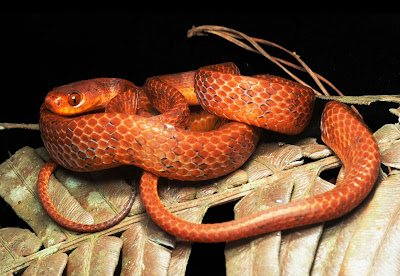 |
| Pareas geminatus Ding, Chen, Suwannapoom, Nguyen, Poyarkov & Vogel, 2020 |
Abstract
An investigation of the taxonomic status of Pareas hamptoni (Hampton's Slug snake) based on morphological and molecular data revealed a new distinct species from the Golden Triangle region (comprising parts of southern China, and adjacent Laos and Thailand). The new species is shown to be a sister species to P. hamptoni but can be separated from the latter by having 3–5 dorsal scale rows at midbody slightly keeled (vs 5–9 scales strongly keeled); a lower number of ventrals, 170–188 (vs 185–195); and a lower number of subcaudals, 67–91 (vs 91–99). The new species is currently known from northwestern Thailand, northern Laos, and the southern part of Yunnan Province in China at elevations of 1,160–2,280 m a.s.l. We suggest that the new species to be considered of Least Concern (LC) in the IUCN's Red List categories. Problems of taxonomy and actual distribution of the P. hamptoni complex are briefly discussed; our results show P. hamptoni is now reliably known only from Myanmar and Vietnam, but its occurrence in Yunnan Province of China is likely.
Key words: China, Indo-Burma, Laos, Pareas formosensis, Pareas mengziensis, Thailand
 |
| Pareas geminatus sp. nov. in life from the type locality in Jiangcheng, Yunnan, China. |
 |
| Pareas geminatus sp. nov. in life from the type locality in Jiangcheng, Yunnan, China. |
 |
| Pareas geminatus sp. nov. adult male (AUP-00176) from Doi Inthanon National Park, Chiang Mai Province, Thailand. |
Pareas geminatus sp. nov.
Diagnosis. Pareas geminatus sp. nov. differs from all congeners by the combination of the following morphological characters: a slender, yellow-brown, medium-sized snake (total length 566 mm); one or two anterior temporals; loreal not contacting the eye; prefrontal contacting the eye; one preocular; slightly enlarged median vertebral row; usually 7 (6–8) supralabials; 8 infralabial scales; 3–5 scale rows slightly keeled at midbody; 170–188 ventrals lacking lateral keels; 75–91 subcaudals, all divided; slightly billowing vertical dark bars on the trunk; two slight thin black postorbital stripes starting from lower and upper edges of postorbital scales; lower postorbital stripe reaching the anterior part of seventh supralabial, not continuing to the lower jaw and chin; the left and right upper postorbital stripes merge forming a black nuchal collar.
Etymology. The specific epithet "geminatus" is a Latin adjective in nominative singular (masculine gender) derived from the Latin "geminus", for "twin", "double", and is given in reference to the similarity in morphology of the new species to its sister taxon, P. hamptoni, with which it was confused for a long time.
We suggest the following common names: "Twin Slug snake" (English) and "Bó Zhòng Dùn Tóu Shé" (伯仲钝头蛇) in Chinese. งูกินทากลายขวั้น ງູກິນທາກລາຽຂວັ້ນ
Distribution and natural history. The known distribution of Pareas geminatus sp. nov. is shown in Fig. 1. The new species is currently known from the Golden Triangle area, including the southernmost part of Yunnan Province, the northwestern part of Thailand, and the northern part of Laos. The occurrence of the new species in the extreme eastern corner of the Shan Plateau in Myanmar is anticipated. At the type locality in Jiangcheng County, Yunnan, China, Pareas geminatus inhabits tropical monsoon forests with clearly defined dry and wet seasons at elevations from 1,160 to 2,280 m asl. The new species was also recorded in highly modified secondary habitats with tea plantations (Fig. 5). The specimens of Pareas geminatus were observed at night after 2100 h while perching on vines or bushes ca. 1.0–1.5 m above the ground, waiting for prey. In China, the new species is threatened by intensifying human activity due to increasing deforestation for tea cultivation.
Li Ding, Zening Chen, Chatmongkon Suwannapoom, Tan Van Nguyen, Nikolay A. Poyarkov and Gernot Vogel. 2021. A New Species of the Pareas hamptoni Complex (Squamata: Serpentes: Pareidae) from the Golden Triangle. TAPROBANICA: The Journal of Asian Biodiversity. 9(2); 174-193. DOI: 10.47605/tapro.v9i2.230


